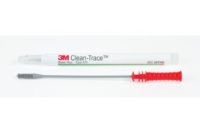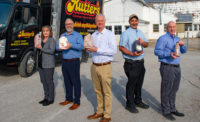
With A Trace
by Lynn Petrak
RFID, track-and-trace technology enable processors to
make sure everything is in its place.
These days, it’s not
enough for dairy manufacturers to ship products from Point A to Point B
— they pretty much need to follow their perishable goods through to
Point Z.
With the specter of recalls and concerns about
inefficiencies and waste looming large, more manufacturers are taking
advantage of improving technology to keep tabs on the entire chain from
farm to fork (or cup, as it may be). The ability to trace raw ingredients
and finished products backward and forward helps processors become both
proactive and reactive and can provide them with a wealth of strategic
information.
To be sure, there are many types of tracking tools
available. Dairy manufacturers employ a variety of track-and-trace systems,
utilizing specialized software and hardware that allows them to monitor
internal production and connect with suppliers and customers. Some
processors have pursued radio frequency identification (RFID) technology,
through which tiny transmitter tags that store data are affixed to a pallet
or case.
Wells’ Dairy Inc., the LeMars, Iowa-based
manufacturer of frozen and cultured dairy products, is among the companies
that have invested heavily in traceback and RFID. “From the outset,
we viewed the implementation of this technology as a catalyst for making
process changes that improve business performance,” says Wells
process control manager Brad Galles, who points to several tangible
benefits of its state-of-the-art RFID capability. “Once the data is
collected, we’ll use it to improve inventory tracking, automate many
of our quality control and inventory processes and simplify our data
collecting processes.”
Those who supply tracking services and equipment agree
that many factors are converging to cause dairies to take a closer look at
the technology. “Track and trace is important due to concerns about
shelf life, inventory management, recall and legislation concerning the
Bioterrorism Act,” notes Chuck Ravetto, director of marketing for
Wood Dale, Ill.-based Videojet Technologies Inc., a supplier of coding,
printing and laser marketing products that is part of Danaher Corp.’s
Product Identification Strategic Platform. “Shelf life is important
as it relates to customer satisfaction, inventory management and health
concerns, and the Bioterrorism Act is leading to more traceability to the
ingredient level.”
Such trends are underscored by Eamonn O’Mahony,
director of product development for Softtrace Ltd., an Irish firm
specializing in software and solutions. “The ability to minimize
exposure on product recalls, through internal quality checks and system
alerts when problems occur, is becoming increasingly important. And EU and
FDA directives on food safety and traceability have increased focus on this
area of food production over the last number of years,”
O’Mahony says. “In the current environment, any procedures and
systems which provide solutions to these problems will give a company a
competitive advantage.”
When competitive advantage is at stake, it’s no
surprise that those whose business is perishable products are gung-ho about
traceability. “The milk from one cow, in principle, could be used to
make milk, cheese and ice cream and end up in processed foods all over the
place. That’s why it’s so important, if you have [potentially]
contaminated food like dairy, to find out not just what caused it, but how
it all ended up,” says Stein Onsrud, chief executive officer of the
Americas group for TraceTracker USA Inc., a Norwegian firm with U.S.
offices in San Rafael, Calif.
What’s New
Track-and-trace systems, which include software
programs and hardware like hand-held computers, are available in broad
range of forms today.
According to Onsrud, TraceTracker has continually
updated its whole system solutions that allow dairy manufacturers to trace
products internally and link in real time with key partners. “In one
way, you can see we are the ‘Google’ of traceability,” he
says of the company’s cold-chain capability that works from both RFID
and bar codes. “If it’s a big dairy farm wondering what
happened to a bad batch of milk that went through, they will then, via the
host server, check with different chain members like retailers, processors
and everywhere else as it moves forward in the supply chain.”
Onsrud says TraceTracker’s service is different
for several reasons. For one thing, it doesn’t feature a large
database, which was done for security. “In a closed environment, you
have chain members who agree on what and how to share information,’
he says, adding that the systems’ graphic interface is also unique in
that it allows a user to move easily from internal to global traceability
views. In addition, he notes, the system allows temperature to be logged
throughout distribution.
Meanwhile, Videojet continues to upgrade its
offerings, including inkjet, laser marking, labeling and thermal transfer
overprinting (TTO) technologies that can carry information on lot, batch,
date, time, production line, shift and other relevant data. In the past
year, Videojet developed a new 1310 inkjet printer that maximizes uptime by
starting and stopping without the need for cleaning and that was designed
with an automated backflushing nozzle, and also introduced a new DataFlex® Plus TTO
that provides on-line printing of variable and real-time data, such as
expiration dates, batch/lot codes, ingredients/parts listings, bar codes
and logos.
Videojet’s latest model, which launched in April,
is its 3320 laser coder, designed for high-speed production lines.
According to Ravetto, the coder can be integrated into any application that
requires permanent marking of variable data on substrates like plastic,
glass, rubber, cardboard and labels.
For its part, Softrace offers the latest integrated
software solutions that provide data capture, total quality visualization
throughout the chain, yield management at specified points in the cycle and
product value optimization. According to O’Mahony, much of the
company’s recent work has centered on customization. “We have
developed customized solutions for different aspects of the dairy
industry, like Softtrace Cheese and Softtrace Liquid Milk,” he says.
“This has allowed us to provide better and more automated solutions,
which are tailored to specific needs.”
Innovations aside, there are some challenges in
track-and-trace applications in the dairy industry. Ravetto, for his part,
points out that wet dairy-production environments meant that
Videojet’s inkjet printers had to be designed to withstand harsher
conditions. “Bar codes are challenging because of the moisture on the
products and curvature of the products, and RFID applications in dairy can
be more challenging as liquids impair the signal transmissions,” he
says. “The other issue is limited space to print all the information
on small products.”
Playing Tag
Bar codes are more commonly used for tracking of dairy
pallets and cases than RFID tags, mainly due to difficulties in reading
tags on or near liquid products. “The frequency being used right now
is in the 900 megahertz (MHz) range, and it is sensitive to any type of
moisture,” explains Rick Fox, president and CEO of Fox IV
Technologies Inc., a Pittsburgh-based provider of equipment and systems for
printing and automatically applying RFID and bar-code labels.
That said, manufacturers have had to find ways to get
around such technical glitches, following the mandate from major retailers
like Wal-Mart, Albertsons and Target that their top suppliers comply with
certain electronic product code (EPC) requirements and use RFID tags. More
stringent traceability requirements from foodservice titans like
McDonald’s, too, have spurred new RFID solutions. “You’ll
find a lot of creativity going on out there at the tag level,” Fox
says, “with tag and antennae design, and the location of the
tag.”
In the dairy industry, Fox was involved with the
incorporation of RFID into Wells’ Dairy, where the technology was
applied to ice cream, which has less of a concern with moisture.
“What is interesting on that application is that there are two
five-quart ice cream containers nested against each other and
shrink-wrapped,” he says of the location of the RFID tag.
According to Galles, Wells’ Dairy wanted to
integrate RFID into the plant’s existing Rockwell Automation
infrastructure for a maximum return on investment. The system they settled
on is based on Rockwell Automation Integrated Architecture, using
Allen-Bradley® ControlLogix® controllers, NetLinx networking technology and the ViewAnyWare visualization
platform to improve integration and exchange of information throughout the
facility.
Currently, on the Wells’ Dairy ice cream line, an
RFID tag is embedded in the bar-code label placed on the plastic wrap by an
applicator, and the tag is read as cases begin to move into the freezer. If
the reader doesn’t recognize the tag, the case is rerouted to another
line and manually reviewed by a line employee. After gallons are placed
into a pallet covered in plastic wrap, another RFID tag is placed on the
pallet, containing information gathered on the individual ice cream buckets
as they moved throughout the production process.
After working out the bugs in the system, Galles says
other benefits of RFID have come to light. “In addition to the
opportunities that we defined in the business case of this project, we
realized other areas where this technology brings added value to
Wells’ Dairy,” he says, citing freed-up personnel, increased
safety and quality control, enhanced productivity, improved shipping
accuracy and improved insight into inventory.
Companies that offer RFID systems to food manufacturers
continue to develop new applications and educate processors about the
technology. The Kennedy Group, a Willoughby, Ohio-based developer and
manufacturer of labeling, packaging, promotional labels and identification
systems, recently partnered with Alien Technology to purchase large volumes
of inlays and other products for production of Smart Therm labels and
smart cards. Such labels make it easier to read tags.
Meanwhile, Telford Park, Pa.-based Accu-Sort Systems
Inc. (whose sister company is Videojet) offers an integrated RFID and bar
code system called Fast Tag® that is used by top suppliers of Wal-Mart. In recent months,
Accu-Sort launched Fast Tag® Start, an entry-level kit for those looking to
experiment with RFID technology or to do an initial pilot.
In another development, the U.K.-based data collection
company and consultant group IDTechEx has put 500 case studies online to
help food executives learn from the best and worst in the industry. The
online database includes 1,600 cases of RFID in action, of which 500 focus
on food and livestock tagging.
Lynn Petrak is a freelance journalist based in the
Chicago area.
$OMN_arttitle="With A Trace";?>

